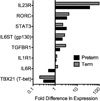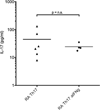Developmental regulation of Th17-cell capacity in human neonates
- PMID: 22101893
- PMCID: PMC3414367
- DOI: 10.1002/eji.201141847
Developmental regulation of Th17-cell capacity in human neonates
Abstract
Human neonates are at significantly greater risk of serious infection than immunocompetent adults. In particular, very low birth weight infants in the neonatal intensive care nursery are at high risk of developing life-threatening bacterial and fungal infections. Recent studies have identified Th17 cells as critical mediators of immunity to bacterial and fungal infections at epithelial barriers. Little is known, however, about the ontogeny of Th17-cell responses in humans. The frequency of serious bacterial infections in preterm infants and the importance of Th17 cells in providing protection against such infections in animal studies prompted us to study Th17-cell development in human neonates. Naïve CD4(+) T cells from extremely preterm infants, term infants, and adults were assayed for their capacity to develop into Th17 effector cells. Surprisingly, Th17-cell capacity was inversely related to developmental age. Neonates expressed higher levels of IL-23R, RORγt, and STAT3 prior to activation and showed a significant Th17-cell bias after activation. In contrast, adult cells expressed more TBX21 with a corresponding Th1-cell bias. CD161 expression on Th17-cell precursors was also developmentally regulated. Our results suggest there is significant developmental regulation of CD4(+) effector lineages with a strong bias toward Th17-cell development early in life.
Copyright © 2012 WILEY-VCH Verlag GmbH & Co. KGaA, Weinheim.
Figures





References
-
- Lewis DB, Wilson CB. Developmental Immunology and Role of Host Defenses in Fetal and Neonatal Susceptibility to Infection. In: Remington JS, Klein JO, editors. Infectious Diseases of the Fetus and Newborn Infant. Seventh Edn. Philadelphia: Elsevier Saunders; 2011. pp. 80–191.
-
- Randolph DA, Lewis DB. Transient deficiencies of T-cell-mediated immunity in the neonate. Adv Exp Med Biol. 2006;582:55–69. - PubMed
-
- Stoll BJ, Hansen N, Fanaroff AA, Wright LL, Carlo WA, Ehrenkranz RA, Lemons JA, Donovan EF, Stark AR, Tyson JE, Oh W, Bauer CR, Korones SB, Shankaran S, Laptook AR, Stevenson DK, Papile LA, Poole WK. Late-onset sepsis in very low birth weight neonates: the experience of the NICHD Neonatal Research Network. Pediatrics. 2002;110:285–291. - PubMed
-
- Weaver CT, Hatton RD, Mangan PR, Harrington LE. IL-17 family cytokines and the expanding diversity of effector T cell lineages. Annu Rev Immunol. 2007;25:821–852. - PubMed
Publication types
MeSH terms
Substances
Grants and funding
LinkOut - more resources
Full Text Sources
Research Materials
Miscellaneous

